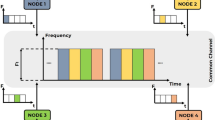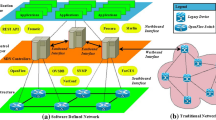Abstract
This paper proposes a numerical analysis model to predict the processing delay of a hardware architecture for robust header compression and packet aggregation on wireless mesh networks. The analysis model is composed of a series of queue systems such as G/M/1, M [K]/M/1, M/M/1, and M/M/∞ that are one-to-one mapped into the constructed hardware components to characterize the concurrent operations and interactional relationship between encoding and decoding paths. Based on the co-simulation method which integrates NS-2 and SystemC, we show the analysis model properly approximates the processing delay of the hardware architecture. Additionally, the variation of processing delay occurring when a part of hardware components are differently configured is suitably characterized by the proposed model, and the overall mesh network behaviors is predicted by applying the numerical results into NS-2 simulations.













Similar content being viewed by others
References
Akyildiz, I. F., & Wang, X. (2005). A survey on wireless mesh networks. IEEE Communications Magazine, 43(9), S23–S30.
Bormann, C., Burmeister, C., Degermark, M., Fukushima, H., Hannu, H., Jonsson, L-E., Hakenberg, R., Koren, T., Le, K., Liu, Z., Martensson, A. Miyazaki, A., Svanbro, K., Wiebke, T., Yoshimura, T., & Zheng, H. (2001). Robust header compression (ROHC): Framework and four profiles: RTP, UDP, ESP, and uncompressed. RFC 3059, July.
WiMAX Forum, http://www.wimaxforum.org/.
3GPP, http://www.3gpp.org.
Taylor, D. E., Herkersdorf, A., Doring, A., & Dittmann, G. (2005). Robust header compression (ROHC) in next-generation network processors. IEEE/ACM Transactions on Networking, 13(4), 755–768.
Jung, S., & Hong, S. (2008). Network/hardware cross-layer evaluation for ROHC and packet aggregation on wireless mesh networks. ACM/Springer Wireless Networks, February.
Gross, D., Shortle, J. F., Thompson, J. M, & Harris, C. M. (2008). Fundamentals of queueing theory (4th ed.). NJ: John Wiley & Sons.
Network Simulator-2, http://www.isi.edu/nsnam/ns.
SystemC, http://www.systemc.org.
Jacobson, V. (1990). Compressing TCP/IP Headers for low-speed serial links, RFC 1144, February.
Arnau, M., Calveras, A., & Paradells, J. (1999). A controlled overhead for TCP/IP header compression algorithm over wireless links. In International conference on wireless communications.
Casner, S., & Jacobson, V. (1999). Compressing IP/UDP/RTP headers for low-speed serial links. RFC 2508, February.
Degermark, M., Hannu, H., Jonsson, L., & Svanbro, K. (2000). Evaluation of CRTP performance over cellular radio links. IEEE Personal Communications, 7(4), 20–25.
Kim K., & Hong, S. (2006). VoMESH: Voice over wireless MESH networks. IEEE Wireless Communications and Networking Conference, 1, 193–198.
Ashish Jain, M. N. D. G., & Gruteser, Marco (2003). Benefits of packet aggregation in ad-hoc wireless network. Department of Computer Science, University of Colorado at Boulder, Technical Report CU-CS-960-03.
Yamada, H., & Higuchi, N. (2001). Voice quality evaluation of ip-based voice stream multiplexing schemes. In IEEE Conference on Local Computer Networks, pp. 356–364.
Komolafe, O., & Gardner, R. (2003). Aggregation of VoIP streams in a 3G mobile network: A teletraffic perspective. In European personal mobile communications conference (EPMCC), pp. 545–549.
Lin, Y. D., Lin, Y. N., Yang, S., & Lin, Y. (2002). DiffServ over network processors: Implementation and evaluation. In IEEE Symposium on high performance interconnects, pp. 121–126.
Blake, S., Black, D., Carlson, M., Davies, E., Wang, Z., & Weiss, W. (1998). An architecture for differentiated services. RFC 2475, December.
Johnson, E. J., & Kunze, A. R. (2002). IXP1200 programming. Santa Clara, CA: Intel Press
Persaud, R., Sabath, D., Berghoff, G., & Schanko, R. (2006). Performance evaluation of MPLS and IP on an IXP1200 network processor. IEEE international conference on advanced information networking and applications, 2, 413–417.
ROHC-Robust header compression, http://rohc.sourceforge.net.
Perkins, C., Belding-Royer. E., & Das, S. (2003). Ad hoc on-demand distance vector (AODV) Routing, RFC 3561.
Mica Motes, http://www.xbow.com/Products/Wireless_Sensor_Networks.htm.
Cole, R., & Rosenbluth, J. (2001). Voice over IP performance monitoring. ACM Computer Communication Review, 31(2), 9–24.
RouterBOARD, http://www.routerboard.com.
Author information
Authors and Affiliations
Corresponding author
Rights and permissions
About this article
Cite this article
Jung, S., Hong, S. Numerical analysis of hardware architecture for header compression and packet aggregation on wireless networks. Wireless Netw 16, 1477–1491 (2010). https://doi.org/10.1007/s11276-009-0215-9
Published:
Issue Date:
DOI: https://doi.org/10.1007/s11276-009-0215-9




